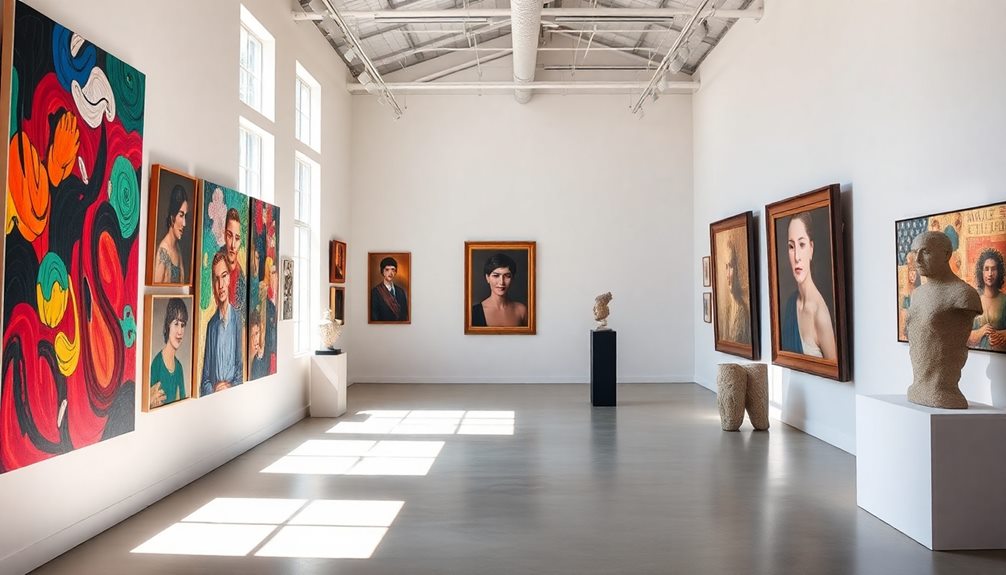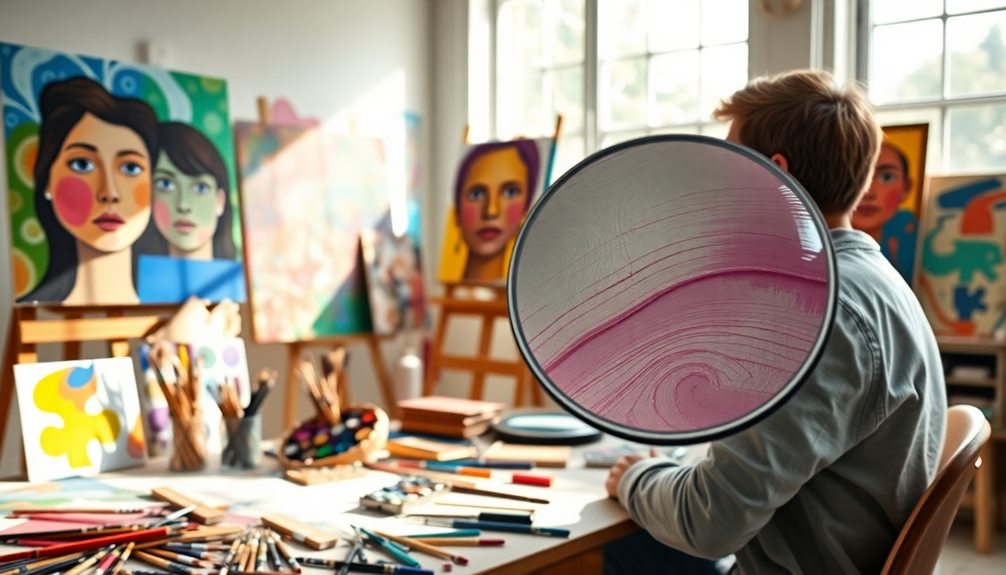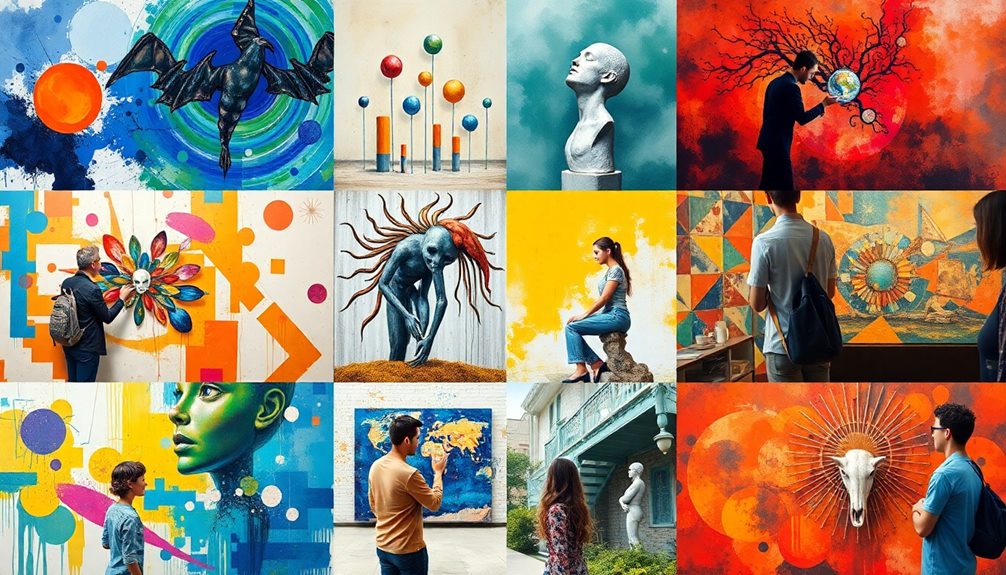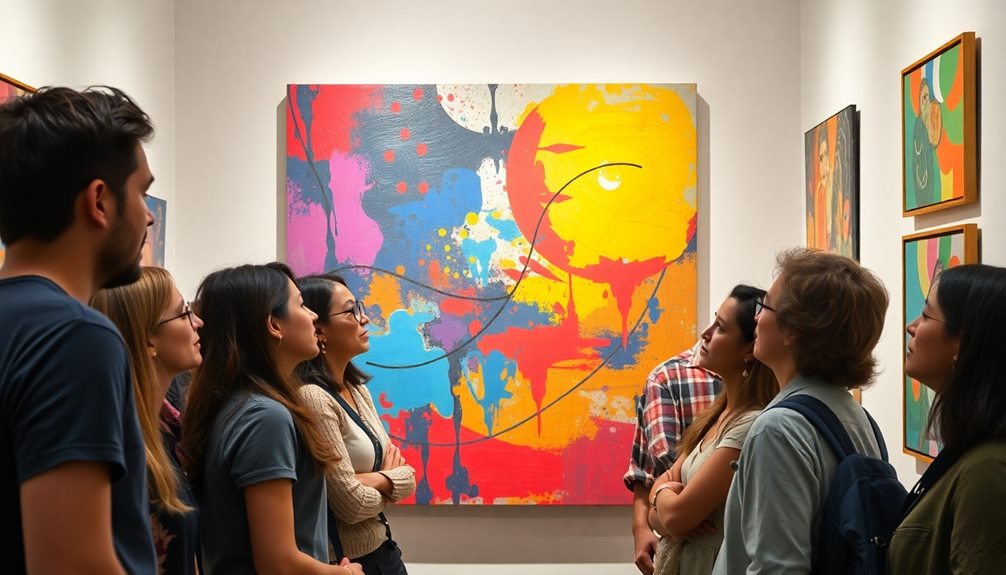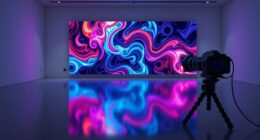The psychology of art appreciation taps into your emotional, cognitive, and cultural experiences to shape how you connect with art. You encounter aesthetic pleasure and emotional responses that intertwine with your memories and personal history. Neuroscience shows that your brain activates in similar ways when creating and appreciating art, fostering deeper connections. Factors like cultural background and the environment, such as galleries, influence your emotional openness and interpretation. By engaging actively with these elements, you can enrich your appreciation and understanding of artwork, uncovering layers of meaning along the way. Explore further to discover even more insights!
Key Takeaways
- Art appreciation involves emotional, cognitive, and aesthetic experiences that deepen personal connections to artwork.
- Cultural context significantly influences how individuals perceive and emotionally respond to art.
- Neuroscience shows that engaging with art activates brain regions linked to emotion and memory.
- Personal experiences and memories enhance emotional engagement, shaping unique interpretations of art.
- Theoretical frameworks help understand diverse appreciation experiences, including aesthetic pleasure and emotional resonance.
Introduction
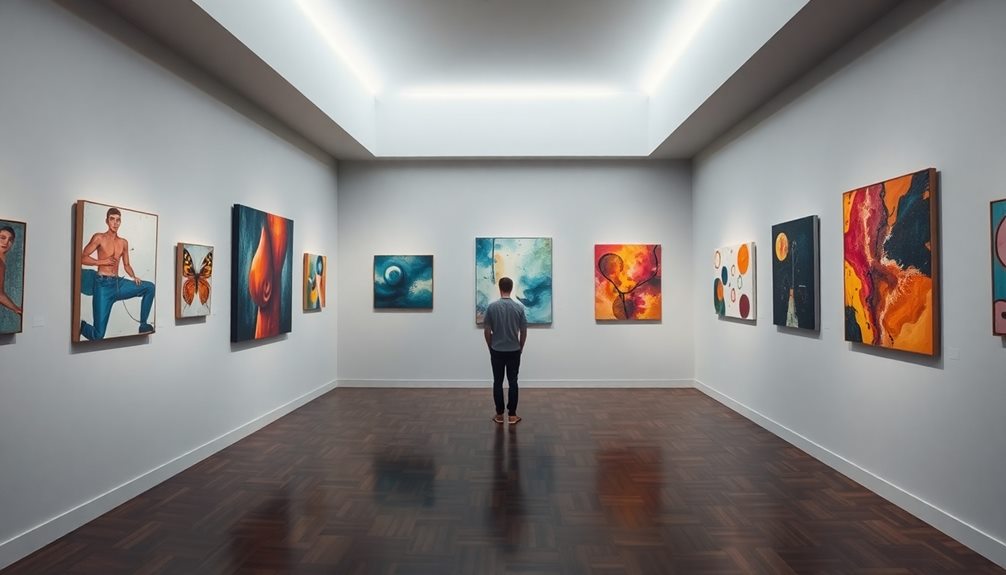
Art appreciation isn't just about looking at a piece and forming an opinion; it dives deep into how you perceive, experience, and value art on various psychological levels. The psychology of art appreciation explores the intricate ways you connect with art through different frameworks and theories.
Five distinct types of art appreciation experiences have emerged: aesthetic pleasure, emotional appreciation, cognitive appreciation, aesthetic fascination, and heightened awareness. Each of these experiences taps into different psychological schools of thought, enriching your overall understanding.
Key figures like Rudolf Arnheim and Daniel Berlyne have significantly shaped this field, highlighting the emotional impact and psychological dimensions of aesthetics. An existential-phenomenological approach further emphasizes how art profoundly influences your life, fostering personal connections and deeper emotional responses to artworks.
Moreover, recent neuroscience research reveals that the processes of creating and appreciating art light up similar brain regions. This finding underscores the shared neural mechanisms at play, suggesting that your engagement with art isn't merely a passive experience but an active, cognitive process that resonates deeply within you.
Understanding these facets can enhance your aesthetic experience, allowing you to appreciate art on a richer, more meaningful level.
Key Concepts and Definitions
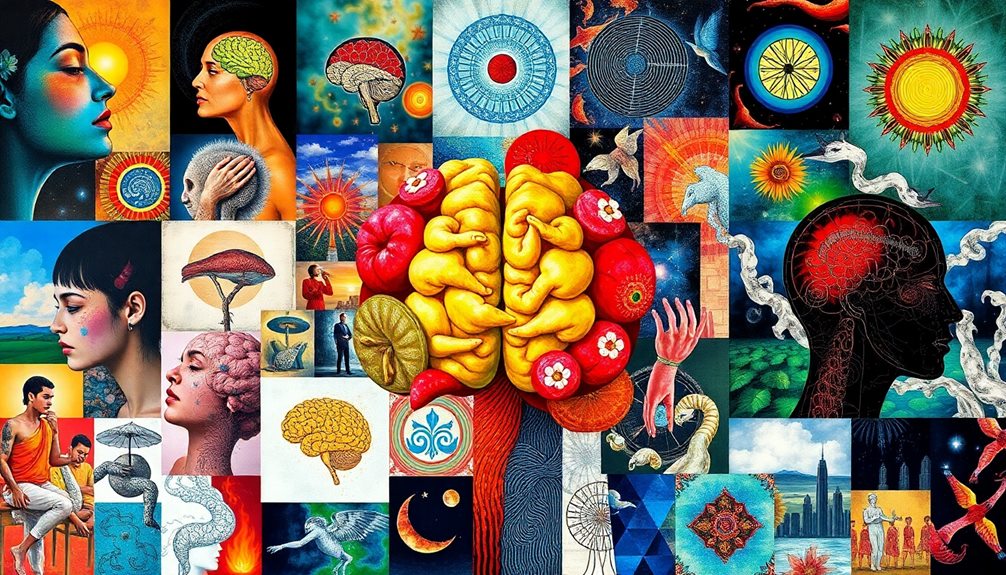
Understanding the nuances of art appreciation requires familiarity with several key concepts and definitions that underpin the experience. Art appreciation isn't just about enjoying what you see; it's a multifaceted experience that includes aesthetic pleasure, emotional appreciation, cognitive appreciation, aesthetic fascination, and heightened awareness. Each of these types is rooted in different schools of psychology, highlighting the diverse ways you can engage with art.
The existential-phenomenological approach emphasizes how art profoundly influences your life and the personal connections you forge with artworks. Figures like Rudolf Arnheim and Daniel Berlyne have shaped the psychology of aesthetics, offering insights into how individuals interact with and value art.
Aesthetic cognitivism suggests that the value of art extends beyond mere emotional responses. It invites a deeper understanding of the human condition and moral concepts through aesthetic experiences.
Research shows that both creating and appreciating art activate similar brain regions, demonstrating the interconnectedness of these activities and their shared emotional engagement. By grasping these key concepts, you can enrich your own art appreciation journey and deepen your psychological connection to the artwork around you.
Neuroscience of Art Engagement
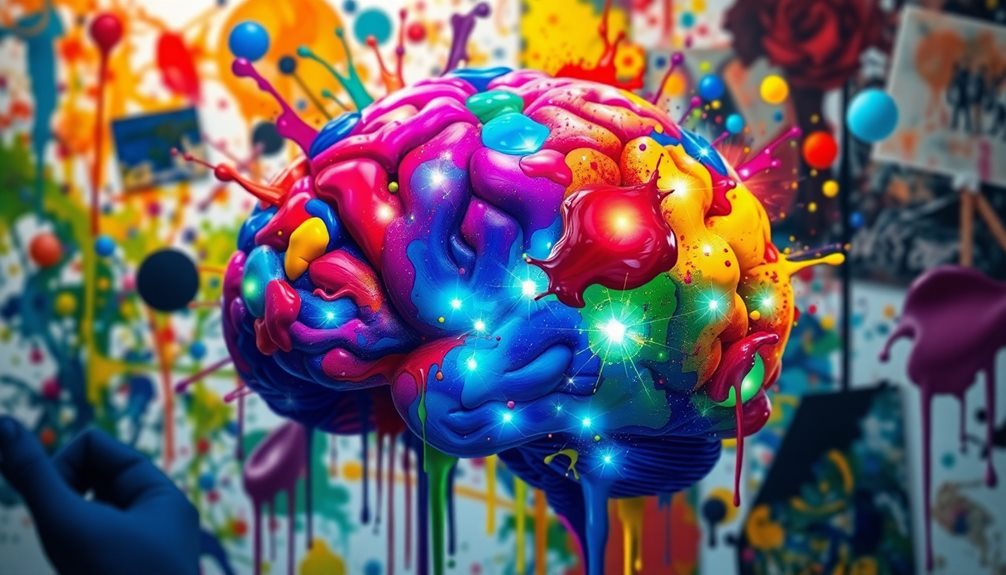
Engaging with art sparks a fascinating interplay between emotion and cognition within your brain. When you appreciate visual art, overlapping brain regions, particularly in the prefrontal cortex and the ventral visual stream, activate, highlighting how closely intertwined creativity and appreciation are.
fMRI studies reveal that your emotional responses, driven by neural activity in areas like the parahippocampal gyrus and fusiform gyrus, are crucial for memory and object recognition.
As you engage with art, emotional connections enhance your experience, increasing brain activity and deepening your appreciation. The environment also plays a key role; museums foster emotional openness that significantly heightens your engagement compared to sterile lab settings.
This underscores the psychology of aesthetics, showing how context can enrich your aesthetic judgments. Research indicates that your evaluations of creative works draw from shared cognitive and emotional pathways, suggesting that appreciating art isn't just a visual experience—it's a holistic one. This interconnectedness highlights the profound role of artistic influence and creativity in shaping how we perceive and value art. Our responses to aesthetics are deeply rooted in cultural, emotional, and experiential factors, revealing that creativity transcends the boundaries of individual perception. Ultimately, this interplay between the mind and environment showcases how art can evoke meaning and connection on multiple levels.
This intricate neural framework connects your emotions and cognitive processes, making art appreciation a deeply enriching aspect of human experience.
Museum Visitor Feedback Analysis
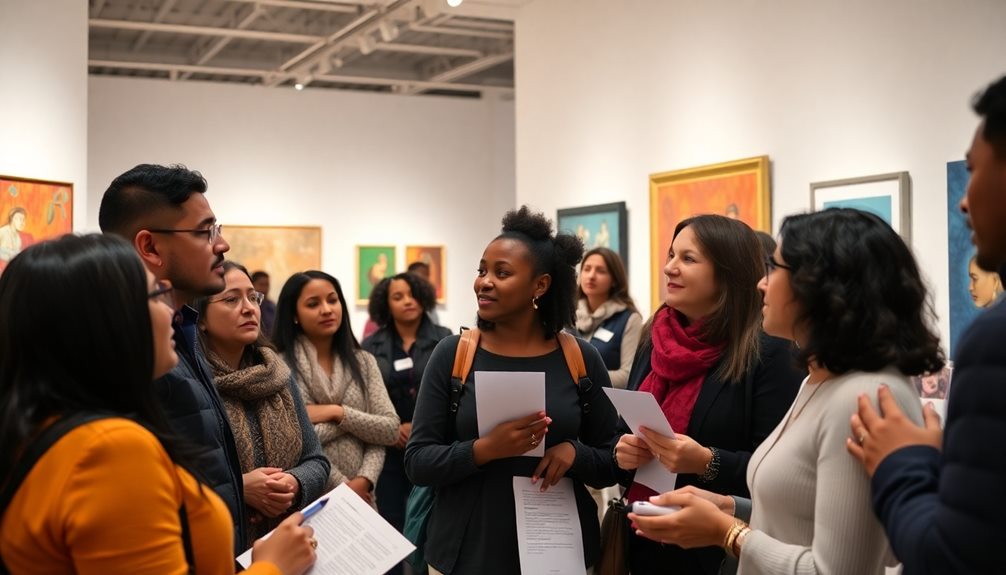
Visitor feedback provides valuable insights into the emotional resonance of museum exhibitions. You might notice that many attendees often highlight the emotional impact of their experiences, expressing heightened feelings of joy and inspiration after interacting with the art.
When you participate in guided tours or educational programs, studies suggest you're likely to provide more positive feedback and report deeper aesthetic experiences than those exploring independently.
Your comments and observations play a crucial role in understanding how contextual elements, like the museum's ambiance and artwork arrangement, significantly influence overall satisfaction. Personal connections to the artwork—whether through relatable themes or cultural significance—enhance your appreciation and understanding.
This is where the emotional impact truly shines, as it allows you to connect more profoundly with what you see.
Moreover, many visitors emphasize the need for accessibility and inclusivity in museum programming. You likely share a desire for diverse representations and engagement opportunities that resonate with a broader audience.
Such feedback not only shapes the visitor experience but also guides museums in fostering a richer environment for art appreciation.
Tips and Best Practices
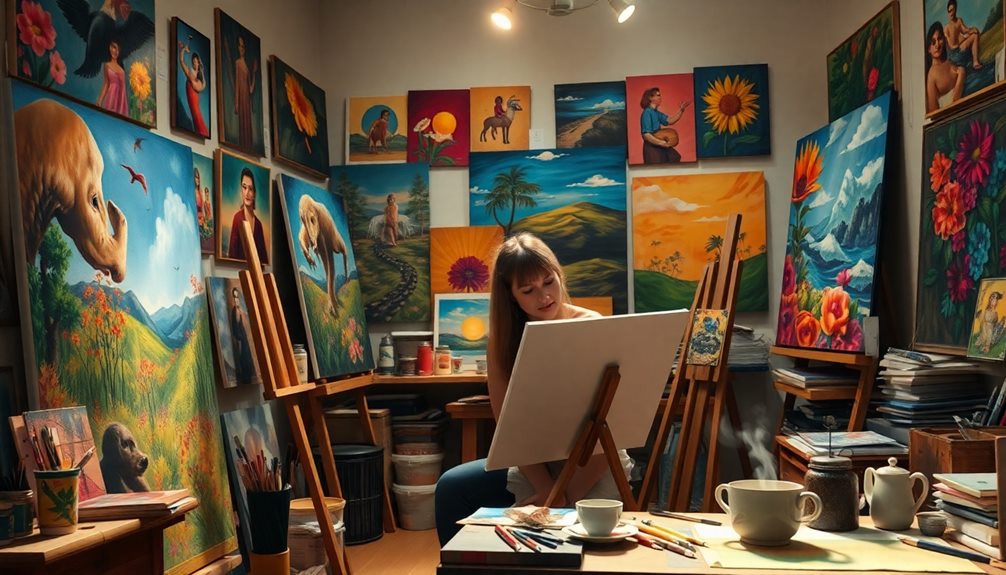
How can you elevate your experience at an art museum? Start by engaging actively with the art around you. Consider the emotional, cognitive, and aesthetic dimensions of your experience. Reflect on the five types of art appreciation: aesthetic pleasure, emotional appreciation, cognitive appreciation, aesthetic fascination, and heightened awareness. This approach will deepen your connection to the artwork.
Explore psychological approaches, like existential-phenomenological theories, to understand the personal connections you form with art. These theories highlight the subjective nature of aesthetic experiences and how they relate to your feelings and thoughts.
Pay attention to the museum's environment. Settings that promote emotional openness can enhance your aesthetic engagement. Notice how the atmosphere influences your reactions to the art.
Lastly, recognize the role of brain activity in art appreciation. Research shows that similar neural structures activate during both creative production and aesthetic viewing, emphasizing the interconnectedness of these experiences.
Audience Emotional Responses

Art evokes powerful emotional responses that can vary widely among individuals. When you engage with a piece of art, your brain lights up in areas tied to emotional processing, like the amygdala and the ventral striatum. This brain activity shows how deeply art appreciation can resonate with you. You might find that certain artworks trigger personal memories or reflect your life experiences, leading to a stronger connection and heightened emotional engagement.
Your emotional responses can differ significantly based on who you are—your personality traits, prior exposure to art, and even your cultural background all shape how you interpret and enjoy what you see. For instance, some people might feel aesthetic pleasure, while others lean more toward emotional appreciation.
The context in which you view art also plays a role; stepping into a gallery usually fosters more emotional openness than, say, viewing art in a sterile environment.
Cultural Context Influences Perception
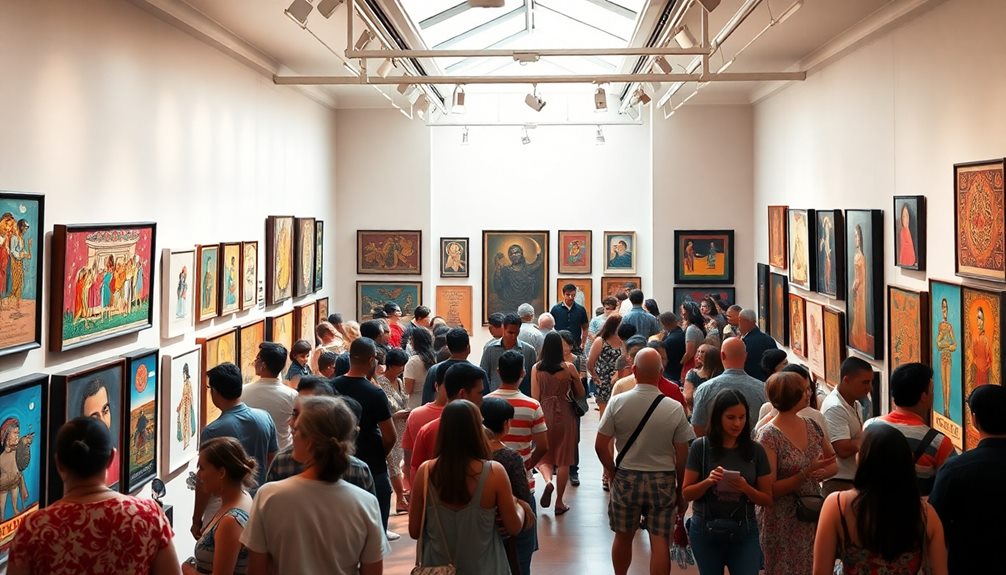
In diverse cultural landscapes, your perception of art is profoundly shaped by the context in which you experience it. Cultural context significantly influences your emotional responses and cognitive evaluations, leading to variations in aesthetic appreciation across different societies.
For instance, when you engage with art from different schools, your background might guide how you interpret themes and judge quality. Research shows that your cultural narrative and historical background inform your expectations and interactions with art, creating a framework for understanding and valuing artistic expressions.
If you visit a museum, the environment can enhance or hinder your emotional engagement, affecting your overall appreciation. Cross-cultural studies reveal that your aesthetic preferences often stem from collective values and traditions, emphasizing the role of cultural identity.
For example, you might find certain colors or symbols more resonant based on your upbringing, while others may evoke different feelings entirely. Ultimately, recognizing the impact of cultural context helps you appreciate art on a deeper level, allowing for a richer, more nuanced experience that honors the diverse backgrounds that inform artistic expression.
Additional Resources

For anyone looking to deepen their understanding of art appreciation, several valuable resources can provide insights and broaden your perspective. One of the most comprehensive texts is Funch's book on the psychology of art appreciation. It explores various theoretical frameworks, including psycho-physical and cognitive approaches, and highlights five distinct types of art appreciation experiences: aesthetic pleasure, emotional appreciation, cognitive appreciation, aesthetic fascination, and heightened awareness.
Each of these experiences links back to different psychological schools of thought, enriching your understanding of how we engage with art.
Key figures in the psychology of aesthetics, like Rudolf Arnheim and Edward Bullough, are discussed in the book, giving you historical context and grounding contemporary theories in established knowledge. Funch's existential-phenomenological approach emphasizes the emotional and subjective connections that individuals form with art, shedding light on the importance of personal experiences in appreciation.
These insights not only enhance your aesthetic understanding but also have practical implications for education, therapy, and cultural appreciation. By engaging with these resources, you can cultivate a richer, more nuanced experience of art that resonates deeply with your personal perceptions.
Frequently Asked Questions
How Does Personal Background Influence Art Appreciation?
Your personal background shapes your taste in art. Experiences, culture, and education inform what you find beautiful or meaningful. You're likely to connect more deeply with art that resonates with your own life story.
Can Art Appreciation Improve Mental Health?
Absolutely, engaging with art can boost your mental health. It allows you to express emotions, reduces stress, and fosters connections with others. So, exploring art can be a powerful tool for enhancing your well-being!
What Role Does Education Play in Art Understanding?
Education enhances your understanding of art by providing context, techniques, and historical significance. It fosters critical thinking and personal interpretation, making you more aware and appreciative of various artistic expressions and their cultural impact.
How Do Different Cultures Define Beauty in Art?
Different cultures define beauty in art through unique values, traditions, and aesthetics. You'll notice that what one culture finds beautiful, another may not. Exploring these differences enriches your understanding and appreciation of global artistic expressions.
Are There Age Differences in Art Appreciation?
Yes, age differences in art appreciation exist. Younger people often prefer vibrant, contemporary styles, while older individuals may gravitate towards classic, traditional works. Your personal experiences and cultural background also shape how you appreciate art.
Conclusion
In conclusion, understanding the psychology of art appreciation enhances your experience as both a viewer and a creator. By exploring key concepts, neuroscience insights, and emotional responses, you can deepen your connection to art. Remember to consider cultural influences and engage actively with artworks in museums. With these tips, you'll not only appreciate art more profoundly but also enrich your own creative journey. So, dive in and let art inspire and transform you!
